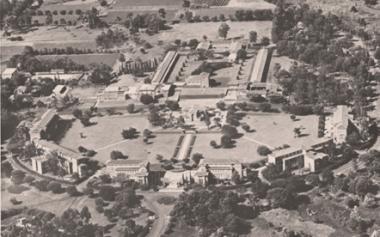Some photos of the Kenya High School have reminded me of the origins of the school. Perhaps a few of you would like to add details or bring the account below up to date? Does the swimming pool still exist, and the open air theatre?
The Kenya High School had its beginnings in 1910 when a co-educational school called the Nairobi European School began in the buildings which were designed for police barracks. In 1931 the boys were separated from the girls and Miss Kerby was appointed as the fist headmistress of the girls’ school. The school was named the European Girls’ Secondary School and the new house names were chosen – Beale, Darling and Nightingale. The school song (words by Mr Biss and music by Mr Lambert) ‘Servire est Regnare ‘ was also the school motto.
The buildings were wooden huts located on the compound of the Nairobi Primary school, with whom the secondary school shared accommodation. Staff housing was scattered in the vicinity of Protectorate Hill. In 1937 the school was renamed the Kenya High School. Due to the Second World War the boarders and staff were evacuated to the Eldoret Hotel in July 1940 where they continued their schooling and returned to Nairobi a year later. By 1942 the student numbers had increased to 150 and Miss Stott succeeded Miss Kerby as headmistress. Overcrowding and a lack of modern facilities created a demand for a new school. A site of 120 acres on Kileleshwa Hill was approved in 1944 and £150.00 was voted in the 1945 budget as a token, for laying out the grounds and the commencement of the building of the present school. The final costs of the buildings and grounds reached £700,000.
By 1948 the number of students had risen to 409 and further houses were established: Kerby in 1943, Huxley in 1944, then Curie in 1945. In 1945 the YWWC building was used to accommodate the senior forms, and forms 4 and 5 and became Senior House. This house became Baden Powell in 1949. The year 1947 saw the establishment of a Junior House in pre-fabricated buildings in the Arboretum, known as Arboretum House. This later became Hamilton. In 1948 the day girls were split between two houses – Darling and Northcote.
In 1950 one hundred boarders moved into the two boarding blocks of the partially completed new school at Kileleshwa, with Miss Rawe in charge and Miss Price and Miss Thomson as housemistresses. In December 1952 the swimming pool was built with the aid of a government loan, and the houses of Mortimer, followed by Bronte, were established. The open air theatre was also laid out and surrounded by many lovely trees and terraces. Numbers swelled to over 700 pupils in 1953 and Mitchell was created. During the Mau Mau, Limuru Girls’ School was evacuated and was accommodated in Mortimer and Mitchell for one term.
In 1959 the chapel was dedicated and in 1963 the library was built. Miss Stott also retired in 1963. So much is owed to her renowned energy and foresight, in getting the new school built and her powers of persuasion with government and planning departments. She it was who got one of the African staff, imprisoned for stealing, released because he had an important role in a school play.
Just prior to Miss Stott’s retirement the first African and Asian girls were admitted, in 1961. Miss Leevers took over the role of headmistress in 1963 and the school became more integrated. Miss Leevers then handed over to Miss Barnes. In 1967 it was decided to extend the plan for Art rooms to include Music Rooms and this block was completed in 1969 when Hon. D.T Arap Moi MP officially opened them.
The first African headmistress, Mrs R Kariuki, took over from Miss Barnes In January 1977 but left in July the same year. Mrs Wanjohi then became headmistress.


Recent Comments